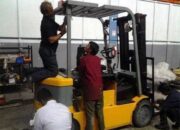Safety standards when working in warehouses need to be paid attention to
In warehouses and ports, keeping workers and pedestrians safe is a very necessary job.
Traffic safety for pedestrians
Forklift operators must always be aware of their workplace, including pedestrian traffic (supervisors or workers working around the aisles). Where possible, it is necessary to separate the forklift traffic from other workers and pedestrians.
Responsibilities of forklift drivers (operators)
Forklift operators in warehouses, wharves, yards… need to be responsible for keeping themselves safe as well as other workers. It is a specific proposal for the benefit and safety of pedestrians.
When a group of people cross the route you plan to drive the forklift through, the best thing the forklift driver does is to stop and wait until the pedestrian has crossed.
Forklift operators should proceed cautiously through any congested areas in warehouses, docks, yards, etc.
The driver should go first through his route will operate the lifting, moving goods before operating a forklift. Think of this as a safety check on your forklift prior to operation.
Forklift
Clear, clear all hazards – all obstacles before going with your standard driving route.
Essential reminders for forklift drivers:
Forklift drivers should always drive slowly for safety while also making it easier to handle some unexpected situations – if not stop and look carefully in all directions at intersections, corners, and any other where your vision is obstructed.
Forklift drivers should also use flashing lights, backup sirens or blue lights when going in reverse.
Some high-traffic areas may require a supervisor to help direct drivers through traffic.
Always maintain clear vision and make eye and hand signals when working with pedestrians and other forklift operators.
Signals for pedestrians must be clear.
Check for smooth stopping, walking, steering and braking.
Necessary reminders for pedestrians in warehouses, wharfs, yards…
Potty riders should be aware that forklifts do not stop suddenly. They are designed to stop slowly to minimize load damage and maintain stability.
The best way to avoid tangled forklift operators, pedestrians or warehouse workers is to always stay still while the forklift truck loads and loads through your standing position.
Remember, forklift operations can have limited visibility due to blind spots.
Never board a forklift unless authorized and the forklift is designed for pedestrians.
Always use a designated pedestrian walkway, or on one side of the lifting equipment.
When possible, you should communicate/signalize the forklift operator.
Reminders for warehouse safety managers
Forklift aisles and fixed aisles are required to be free of obstructions and should be appropriately marked when mechanical handling equipment is used.
Consider separating pedestrians from forklift traffic by providing the following:
– Use pedestrian walkways.
Use permanent barriers or other protective barriers.
– If pedestrians must share the aisle with the forklift, they must have adequate walking space on at least one side.
– If fences or barriers are not available, a pedestrian crossing may be used.
Other great safety tips for forklift drivers and pedestrians
– Use convex mirrors at corners and blind intersections
– Post and make signs of traffic control signs
– Signs restricting the operating speed of forklifts in warehouses and yards
Many warehouses require skilled forklift drivers and pedestrians to wear reflective safety vests to increase visibility of both objects when working in the warehouse or yard.







